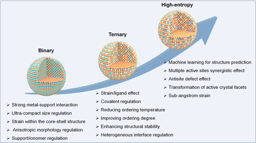Investigating Future Climate Using Climate, Ice Sheet, and Solid Earth Models
Published in Earth & Environment and Mathematics

In a new paper published in Nature Communications we use numerical modeling to investigate how Antarctic meltwater alters future global climate and sea level when ice sheet and climate models interact. We find that meltwater feedbacks change global temperature and precipitation patterns, and show that accounting for solid Earth feedbacks leads to higher regional sea level rise, particularly in the Pacific.
Challenges of modeling ice sheet-climate dynamics
Global climate models are powerful tools for understanding Earth’s climate and constructing projections of future climate under different greenhouse gas emissions pathways. Like all models, they are representations of real world processes, and are always an approximation with room for improving what processes are included and how.
Currently global climate models don't typically include fully dynamic marine-based ice sheets. This is in part due to the difficulty of simulating important aspects like floating ice shelves, the ocean cavities beneath them, and the changes occurring at the intersection where ice meets water and bedrock. As a result, model projections of future climate tend to underestimate the amount of meltwater coming off the Antarctic ice sheet, the effect that meltwater has on global climate, or how meltwater-perturbed climate would impact ice sheet melt rates. To understand how ice sheet meltwater impacts climate, many studies rely on freshwater forcing, where meltwater is added into global climate models to simulate the response.
Global climate models also don’t include models of the Earth’s mantle, which are crucial for predicting sea level changes along global coastlines and understanding ice sheet stability. As ice sheets melt, they become lighter, exerting less force on the bedrock below. As a result, the bedrock rises upwards, which can bring parts of the ice sheet out of contact with warming ocean waters, slowing the pace of melting, particularly under low emissions scenarios. Furthermore, ice sheet models typically predict contributions to global mean sea level, but the solid Earth response and changes to Earth's gravitational field and rotation lead to spatially variable sea level changes across the globe.
Our new study grew from past work by members of the research team who had researched pieces of the physical systems described above including how meltwater from an ice sheet model altered climate projections, how ice sheet and solid Earth interactions impact global sea levels, and the mechanisms behind how meltwater feedbacks alter the pace of global warming. In our new research we wanted to understand how these distinct pieces come together.
Designing our research
Science is a collaborative process, and it benefits from people working together across disciplines and across borders to enhance our global understanding of the planet we all live on.
To build our collaboration I wanted these separate types of models (and modelers!) to come together. We designed an experiment where a global climate model interacted with an Antarctic ice sheet model. The models could co-evolve each simulated year with the climate responding to the meltwater and the ice sheet model predicting the melt quantities in response to the meltwater-perturbed climate. We then ran the results of these simulations with a global sea level model that accounts for solid Earth dynamics, including 3D variations in Earth’s structure. The climate model output was then analyzed to understand the mechanisms that alter radiative feedback processes. We ran these models under a medium and high emissions scenario out to year 2200 and compared them to simulations lacking an interactive ice sheet.
What we found
When compared to simulations lacking meltwater we find enhanced warming in the Northern Hemisphere, with surface air temperatures up to 1.5°C higher over Greenland by the end of the century in a high emissions scenario. At the same time, temperature rise is broadly dampened in the Southern Hemisphere. Due to climate radiative feedback changes (primarily in cloud feedback and sea-ice albedo feedback) resulting from ocean surface warming patterns, global mean surface temperatures in both emissions scenarios are ~0.3°C cooler in 2100 in the coupled climate-ice sheet model, relative to the control simulations. The maximum global mean temperature anomaly between interactive simulations and simulations lacking an ice sheet model reaches ~1°C under high emissions by 2200.
These changes in global temperature evolution slow Antarctica’s contribution to global mean sea level rise. Total Antarctic sea level contributions under high emissions reach ~0.3 m by 2100 and more than 3 m by 2200. This includes substantial contributions from East Antarctica, which is generally thought to be more stable than West Antarctica but which is vulnerable to warming air temperatures that can induce hydrofracturing of ice shelves and lead to faster seaward ice flow and iceberg production.
As would be expected, lower greenhouse gas emissions mean climate impacts are less severe. Under low emissions, our modeling has an Antarctic contribution to global mean sea level rise of ~0.1 m by 2100 and over 1 m by 2200.
Regionally, projected sea level is higher in the Pacific and Indian Ocean basins and in the Caribbean. Under high emissions, regional sea level rise in the Pacific is up to 0.9 m higher than the global mean Antarctic contribution by 2200. The dichotomy between meltwater slowing air temperature rise while accelerating sea level rise has implications for climate justice and should be considered in global policy.
Implications for the future
Model development is always a work in progress and currently modeling teams around the world are working to fully integrate dynamic ice sheet components into climate models. Our work demonstrates how important these efforts are and we look forward to these model updates. Future work integrating ice sheet models, solid Earth models, and global climate models will allow for a more complete understanding of interactions between ice sheets and global climate. While different models simulate different processes and each set of models adds to our understanding of global climate, one thing is extensively well established in the literature: higher emissions will lead to more severe climate and sea level impacts. Lowering emissions is a key step towards a safer future for all.
Cover image of the Southern Ocean from NBP1502, shared by AR Halberstadt.
Follow the Topic
-
Nature Communications

An open access, multidisciplinary journal dedicated to publishing high-quality research in all areas of the biological, health, physical, chemical and Earth sciences.
Related Collections
With Collections, you can get published faster and increase your visibility.
Women's Health
Publishing Model: Hybrid
Deadline: Ongoing
Advances in neurodegenerative diseases
Publishing Model: Hybrid
Deadline: Dec 24, 2025





Please sign in or register for FREE
If you are a registered user on Research Communities by Springer Nature, please sign in